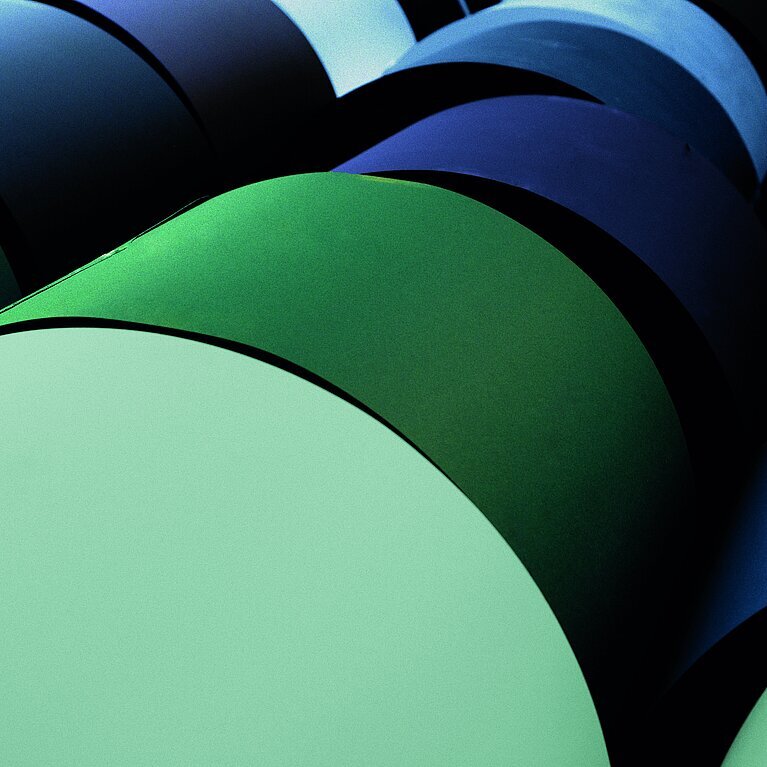

Print is under pressure. For years, the printed circulation of daily newspapers and magazines has been plummeting. At the same time, the demands on paper production to reduce water consumption and wastewater are on the rise. Not to mention the spiraling energy costs. That’s where an established business model quickly becomes a burden. Not so at Tegernsee. Gmund Paper specializes in high-quality papers and excels with sustainable production and innovations, such as a paper made from hemp fibers. Hemp provides more biomass than any other domestic crop, it is harvested three times a year and yields four to five times more paper than a forest area of the same size.
“We are always on the lookout for innovation – that goes for the entire company,” says Managing Director Florian Kohler.

These “extraordinary steps” include, for example, that Gmund is the only company to process industrial water chemical-free with the help of ozone. Environmental protection guarantees the preservation of highly qualified jobs in the Bavarian Uplands. In 1829, today’s Büttenpapierfab rik Gmund GmbH & Co. KG was built on the banks of the Mangfall River and has since kept adapting to the course of time. “Innovation by tradition,” says company spokeswoman Sabine Huber, explaining that ideas are solicited, discussed, tested and eventually implemented. This is part of the company’s philosophy and part of how new papers or unique combinations come to life, she adds. Like the public restaurant “Mangfallblau”. Huber speculates that Gmund is probably the only paper factory with its own restaurant. By the way, Tripadvisor reviews of “Mangfallblau” say: “excellent food, very tasty cappuccino from an excellent barista.”
But what does this collaboration look like? Pens and stickers, post-its and play-doh like at a Design Thinking workshop? "Not exactly, but but also not entirely wrong," says Mahmoudi. In the healthcare sector, for example, the focus lies on the direct exchange with doctors, patients and nursing staff. That's how solutions emerge that hold added value for everyone, he says. " Our Designit motto is: Form follows humanity." Through exchange, ideas are conceived and then discarded again when a better one comes to pass. Design grows with the experts involved. And because in our times design means permanent change, the focus often lies on innovation and innovation support.

While classic paper media are losing ground, Gmund has added high-quality papers to its portfolio. These are used to produce premium brochures or catalogs, but mainly packaging. According to Kohler, this presents an “immense growth area,” as paper is increasingly replacing plastic in response to the demand for sustainable packaging solutions. Paper with superior haptic quality is increasingly being used for printing. This can be felt: The paper crackles, rustles and chirps while the fingertips run over its surface. “Emotions can only be conveyed through haptics,” Kohler believes. That’s why companies are turning “more and more to high-quality design papers. The paper becomes brand ambassador. Gmund offers hundreds of different paper designs in the “Gmund Compendien”, starting from one sheet. In the “Gmund Creative System,” the company from Upper Bavaria supplies some staggering thirty thousand variants, starting from one thousand sheets. For orders of three tons or more, Gmund will even develop a very special customized branded paper, a one-of-akind with its very own color, structure and feel.

The paper manufacturer is also pushing innovations in environmental protection. Whoever thinks that when it comes to paper, there’s barely anything left to improve, let alone change, should really lay their hands on the hemp paper: 100 percent made in Europe.
“The long fibers of this novel material make it firm in its structure, soft in its feel and wild in its look,” Kohler explains, adding: “Gmund hemp is produced without colorants – a real gamechanger.”
Paper manufacturing is a highenergy operation, which is why paper mills are located near water. Also in Gmund, the paper mill of the same name was built directly at the Mangfall River, which winds its way out of the popular recreation lake Tegernsee. The paper factory is located at the exit of Gmund. Almost 200 years of industrial history are reflected there, altered, modernized – and always up to date. Gmund has been FSC® certified since 2006. “Conserving natural resources and acting eco-consciously is our day-to-day routine,” says Kohler. And there are reasons why production continues in Bavaria at all: Without constant investment in environmental protection, Gmund would also have fallen victim to structural change. We are now probably the only paper mill to obtain 100 % of our electricity from hydropower. The company uses sustainable raw materials, separates waste and reduces its water consumption on an ongoing basis.
There is no standstill in times of change: At the Gmund Campus, a team of specialists from the fields of fiber technology, material analysis, paper production, ecology, print and packaging technology, sensing technology and green communication advise new and old customers in the “Greenfibra Labs”. Upon request, the team of packaging specialists, designers and production managers will also turn the jointly developed paper into shelf-ready packaging or a customized direct mailing. It appears as though even after nearly 200 years, the story of Gmund Paper is far from finished.
The interview with Florian Kohler first appeared in mcbw mag 2023.
